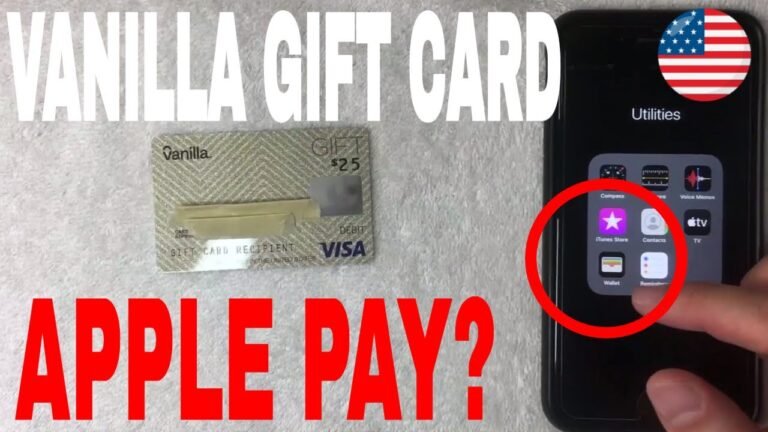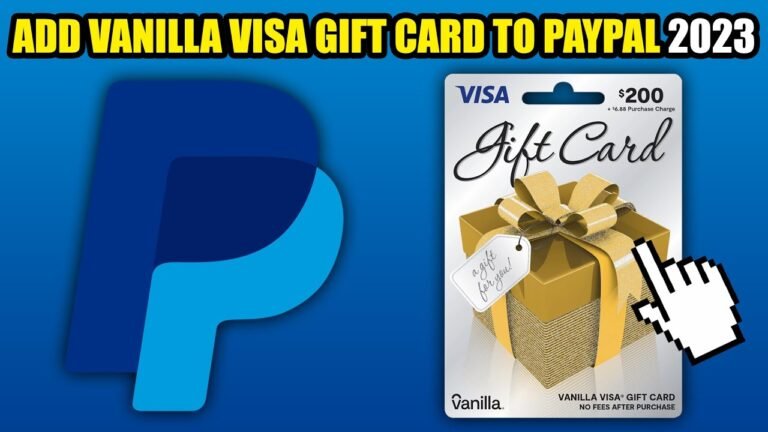Where is Cvv on Visa Gift Card: Quick and Easy Guide
When you receive a Visa gift card, you might be excited to start shopping. But then you realize there’s a crucial piece of information you need: the CVV.
Understanding where the CVV is located on your card can save you time and frustration when making online purchases. You’ll discover exactly where to find this important code and how it plays a role in keeping your transactions secure. Whether you’re new to gift cards or just need a quick refresher, you’ll find everything you need right here.
Let’s dive in so you can start using your Visa gift card with confidence!

Credit: www.reddit.com
What Is A Cvv Code
Understanding the CVV code is crucial when using your Visa gift card. This three-digit number adds an extra layer of security for your online and in-store purchases. Knowing where to find it and how it works can help you use your card safely and confidently.
What Is A Cvv Code?
CVV stands for Card Verification Value. It’s a security feature designed to protect you from fraud. When you enter your card information online, the CVV code helps verify that you are the rightful cardholder.
The CVV code is typically located on the back of your Visa gift card. You’ll find it next to the signature strip. This number is not embossed, making it less likely to be captured by card skimmers.
Why Is The Cvv Code Important?
Using the CVV code adds a layer of protection during transactions. If someone steals your card number but doesn’t have the CVV, they can’t complete many online purchases. This extra step can save you from potential financial loss.
Have you ever experienced unauthorized charges on your account? Many people have, and it’s often because a thief had access to the card number but not the CVV code. Keeping this code secure is one simple way to enhance your financial safety.
How To Use The Cvv Code?
When making a purchase, you’ll usually see a field asking for the CVV code. Simply enter the three-digit number from the back of your card. Always double-check that you’ve entered it correctly to avoid transaction errors.
Be cautious when sharing your card details. Only provide your CVV code on trusted websites. If a site asks for it without a secure connection, think twice before proceeding.
Common Misunderstandings About Cvv Codes
Some people mistakenly believe that the CVV code is the same as the PIN. While both are important for security, they serve different purposes. The CVV is for online transactions, while the PIN is used for ATM or point-of-sale transactions.
Additionally, the CVV code does not appear on your billing statement. This means if you lose your card, the code cannot be easily accessed by someone else. Always treat your gift card like cash and keep it safe.
Understanding the CVV code empowers you to use your Visa gift card effectively. Knowing where to find it and how it protects you can enhance your shopping experience. Always be vigilant, and keep your card information secure.
Purpose Of The Cvv Code
The CVV code plays a vital role in online shopping. It helps keep your transactions secure. Understanding its purpose can enhance your shopping experience.
The CVV stands for Card Verification Value. This code is a security feature. It adds an extra layer of protection for your card. Merchants use it to verify that you are the cardholder.
This code is usually three digits long. You can find it on the back of your Visa gift card. It is essential for online purchases. Entering the CVV helps prevent fraud.
Without the CVV, your transactions may be at risk. It ensures that only you can use the card. Keeping your CVV safe is crucial. Never share it with anyone.
Understanding the CVV’s purpose helps you shop safely. It gives you peace of mind during purchases. Always check for the CVV when entering your card details.
Locating The Cvv On A Visa Gift Card
Finding the CVV on a Visa Gift Card is simple. This small code helps to verify your identity during online purchases. Knowing where to look saves time and hassle.
Back Of The Card
The CVV is located on the back of the Visa Gift Card. Turn the card over to see the signature panel. The CVV code is usually a three-digit number.
It appears to the right of the signature area. Look closely to spot it easily. This code is important for security during transactions.
Near The Signature Panel
Check near the signature panel for the CVV. This area is often where you write your name. The CVV number stands out from the other numbers.
It is separate and clearly marked. Keep your card safe and do not share your CVV with others. Protecting this code helps keep your funds secure.
Difference Between Cvv And Pin
The CVV, or Card Verification Value, is a three-digit code found on the back of a Visa gift card. It helps verify your identity during online purchases. A PIN, or Personal Identification Number, is a secret number used for ATM transactions.
Understanding these differences is key for safe spending.
Understanding the difference between a CVV and a PIN is essential for anyone using a Visa Gift Card. Both serve security purposes, but they function differently in the transaction process. Knowing how each works can help you protect your card and make more secure purchases.What Is Cvv?
The CVV, or Card Verification Value, is a three-digit code found on the back of your Visa Gift Card. This number is used primarily for online and card-not-present transactions. When making an online purchase, you’ll be asked to enter your CVV to verify that you have the physical card in your possession. This helps prevent fraud and unauthorized use.What Is Pin?
A PIN, or Personal Identification Number, is a four-digit code that you create to access your card at ATMs or during point-of-sale transactions. Unlike the CVV, the PIN is not printed on the card and must be memorized. You will need to enter your PIN when making a purchase where the card is physically swiped or inserted. This adds an extra layer of security, ensuring that only you can use your card.Key Differences Between Cvv And Pin
– Usage: CVV is used mainly for online purchases, while a PIN is used for in-person transactions. – Location: The CVV is printed on the back of the card, whereas the PIN is not displayed on the card at all. – Security Purpose: Both are designed to prevent fraud, but the CVV verifies that you have the card during online transactions, while the PIN confirms your identity for in-person transactions. Understanding these differences can save you from potential pitfalls. Have you ever been confused about which number to use during a transaction? Knowing when to use your CVV or PIN can make your shopping experience smoother and more secure.Common Issues Finding The Cvv
Finding the CVV on a Visa gift card can be tricky. It is usually located on the back, next to the signature panel. Sometimes, the CVV may be hard to read or missing, leading to confusion during online purchases.
Finding the CVV on your Visa Gift Card can sometimes feel like a treasure hunt. This little number is crucial for online purchases, but various factors can make it hard to locate. Below are some common issues that might hinder your search for the CVV.Worn Or Faded Numbers
Over time, the numbers on your Visa Gift Card may wear down. This is especially true if you keep your card in your wallet for a long period. If the CVV is faded, it can be nearly impossible to read. Try holding the card under different lighting or using a magnifying glass. If you still can’t find it, check if you have any digital records of the card number. Some retailers or banks send confirmation emails that include the CVV.Card Design Variations
Visa Gift Cards come in various designs. Some cards place the CVV in different locations. You might find it on the back, but some designs have it printed on the front. If your card features a unique design or promotional artwork, the CVV could be hidden in the visual elements. Take a moment to examine all corners of the card. If it’s still not visible, contact the retailer where you purchased the card for assistance. Is the hunt for your CVV turning into a headache? Remember, each card is slightly different, so stay patient and keep searching.Using The Cvv For Online Purchases
Visa gift cards are a convenient and popular choice for gifts, offering flexibility and ease of use both in-store and online. When shopping online, knowing where to find the CVV on your Visa gift card can be crucial for ensuring secure transactions. The CVV, or Card Verification Value, is a three-digit code that helps confirm that you are the rightful owner of the card during online purchases.
Have you ever hesitated before clicking “buy” online because you’re unsure if your transaction is secure? The CVV on your Visa gift card plays a vital role in protecting your purchase. This code acts as an additional layer of security by confirming that you have the physical card in hand.
Typically, you’ll find the CVV on the back of your Visa gift card. It’s the three digits printed on the signature strip, right next to the card’s number. This small code can make a big difference in safeguarding your online shopping experience.
Consider this: You’ve found the perfect gift online, but you’re worried about sharing your card details. Using the CVV helps ensure your transaction is as secure as possible. It reduces the risk of fraud, giving you peace of mind when entering your details on a website.
Online retailers often require you to enter the CVV along with the card number and expiration date. This is why it’s important to know exactly where it is located on your card. Have you checked the back of your card recently?
If you’re new to online shopping, or perhaps a bit cautious, using the CVV might seem daunting at first. But once you know where to find it and how it works, you can shop confidently. Remember, the CVV is there to protect you, so make sure to use it.
Next time you make a purchase online, take a moment to appreciate the security measures in place. The CVV is a small, but powerful tool in your online shopping arsenal. How have you benefited from using the CVV on your Visa gift card?
Tips For Keeping Your Cvv Secure
The CVV on a Visa gift card is usually found on the back. Look for a three-digit number next to the signature strip. Keeping this number safe helps protect your card from fraud. Always keep your card secure and don’t share the CVV with anyone.
Keeping your CVV secure is essential for protecting your Visa gift card from fraud. Knowing where your CVV is located is just the first step. You also need to ensure that this vital piece of information remains confidential. Here are some practical tips to help you safeguard your CVV.Avoid Sharing The Code
Never share your CVV with anyone. This includes friends, family, or anyone who claims they need it for verification purposes. Scammers often pose as legitimate companies to trick you into revealing your CVV. Always remember, if someone asks for your CVV over the phone or through email, it’s likely a scam. Consider this: could a simple conversation put your money at risk? Protect your information fiercely.Use Secure Websites
Always shop on secure websites. Look for “https://” in the URL, which indicates a secure connection. Avoid entering your CVV on unfamiliar sites. Before making a purchase, research the website to ensure it’s reputable. Read reviews and check for any red flags. Using secure payment methods and verified platforms can significantly reduce the risk of fraud. Have you ever hesitated to enter your CVV? Trust your instincts; they often guide you to safer choices. By keeping your CVV secure, you protect not just your funds but also your peace of mind.
Credit: www.youtube.com
What To Do If The Cvv Is Missing
Finding a missing CVV on your Visa gift card can be stressful. The CVV, or Card Verification Value, is important for online purchases. Without it, you may face issues using the card. Here are some steps to take if you cannot find your CVV.
Contact The Card Issuer
First, reach out to the card issuer. Look for a customer service number on the back of the card. Call them to explain the situation. They can guide you through the next steps.
The issuer may ask for details about the card. Be ready to provide the card number and any other required information. They can often help you retrieve your CVV or offer a replacement card.
Alternative Verification Methods
If contacting the issuer does not solve the problem, explore alternative methods. Some online merchants allow you to verify purchases without a CVV. You may need to provide other details, like your billing address.
Check if the merchant accepts payment methods that do not require a CVV. Digital wallets or payment apps may offer different verification options. Always read the payment instructions carefully before completing your purchase.

Credit: www.youtube.com
Frequently Asked Questions
Where Can I Find The Cvv On A Visa Gift Card?
The CVV on a Visa gift card is located on the back, usually in the signature strip. It consists of three digits and is essential for online and phone purchases. Ensure you keep your card safe, as this number protects against unauthorized use.
Is The Cvv The Same As The Card Number?
No, the CVV is not the same as the card number. The card number is typically 16 digits long, while the CVV is a 3-digit code. Always keep both numbers confidential to prevent fraud and unauthorized transactions.
Why Do I Need The Cvv For Online Purchases?
The CVV is crucial for online purchases as it adds an extra layer of security. Merchants use it to verify that the person making the purchase has physical possession of the card. Providing the CVV helps to prevent fraud and protect your financial information.
Can I Use A Visa Gift Card Without The Cvv?
Using a Visa gift card without the CVV may limit your purchasing options. Many online retailers require the CVV for transactions. If you don’t have the CVV, consider using the card in physical stores instead.
Conclusion
Finding the CVV on your Visa gift card is simple. Look on the back of the card. It is the three-digit number next to the signature panel. Keep this number safe. Use it when shopping online or over the phone.
Knowing where to find the CVV helps you use your card easily. Enjoy shopping with your Visa gift card. With this guide, you can confidently make purchases. Remember, always check your card details before completing a transaction. Happy shopping!





